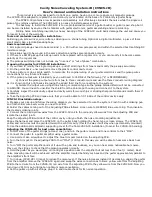
3.3 RESISTANCE MEASUREMENTS
1. Isolate any power which may be present at the resistance to be measured and
discharge any capacitors. Any voltage that may be present during a resistance
measurement will cause inaccurate readings and could damage the meter if the
voltage exceeds the overload protection of 500V DC or AC.
2. Insert the black & red test leads into the COM and
Ω
input terminals
respectively.
3. Select the desired ohms (
Ω
) range
4. Connect the black & red test probe tips to the circuit or device under test,
making sure it is de-energised first.
5. Open circuits will be displayed as an overload condition.
6. Test lead resistance can affect low resistance measurements and should be
subtracted from resistance measurements for accuracy. Select the lowest
resistance range and short the test leads together. The value displayed is the
test lead resistance which should subtracted from the resistance measurement.
7. After completing the measurement, disconnect the test leads.
3.4 CONTINUITY TESTING
1. Select the (
) /
) position by turning the rotary selector switch and
press the "range" button to enter continuity testing.
2. Follow steps 2 & 4 as for resistance measurements
3. The clampmeter emits a tone when measuring resistance of approximately
20
Ω
or less. After measurements have been carried out, disconnect the test
leads from the circuit and from the input terminals of the clampmeter.
3.5 DIODE TESTING
1. Set the (
/
) position by turning the rotary switch and press the
RANGE button to enter Diode testing.
2. Follow steps 2 & 4 as for resistance measurements.
3. The RED lead should be connected to the anode and the black lead to the
cathode. For a silicon diode, the typical forward voltage should be about 0.6V
silicon diode or 0.3V for germanium diode.
4. If the diode is reverse biased or there is an open circuit, the display shows
"OL"
3.6 FREQUENCY MEASUREMENTS
1. Set the rotary selector switch to the desired position
2. Plug the black and red test leads into the "COM" and "Hz" input terminals
respectively
3. Determine that the amplitude level of the signal to be measured is not greater
than the input voltage limit (500Vac/Vdc). The signal amplitude must also be
greater than the sensitivity level.
4. Attach the probe tips to the points across which the frequency is to be
measured, and read the result directly from the display.
5. Disconnect the test leads.
8
9
WARNING
Attempting resistance or continuity measurements on live circuits can
cause electrical shock, damage to the instrument and damage to the
equipment under test. Resistance measurements must be made on
de-energised (DEAD) circuits only, for maximum personal safety. The
electronic overload protection installed in this instrument will reduce
the possibility of damage to the instrument but not necessarily avoid
all damage or shock hazards.
CAUTION
Measurements must only be made with the circuit power OFF




























